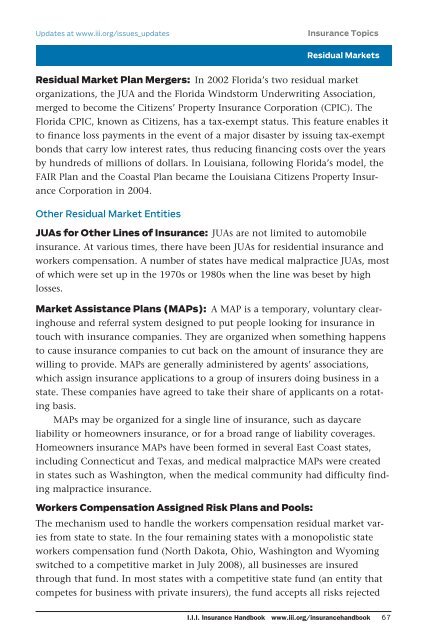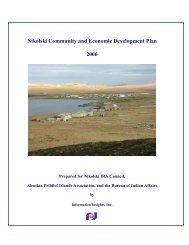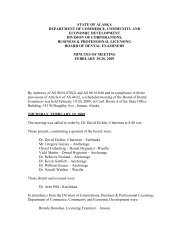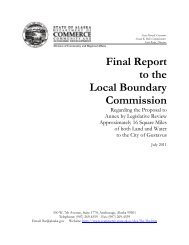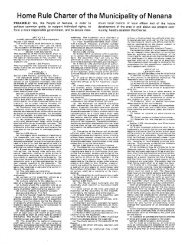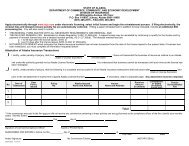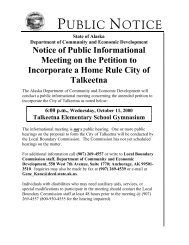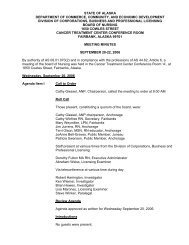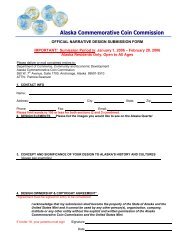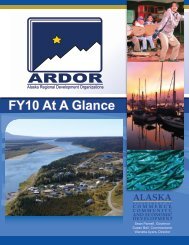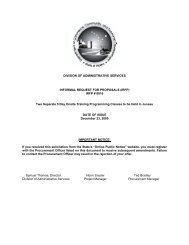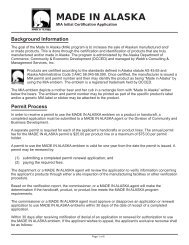Insurance Handbook - Alaska Department of Community and ...
Insurance Handbook - Alaska Department of Community and ...
Insurance Handbook - Alaska Department of Community and ...
You also want an ePaper? Increase the reach of your titles
YUMPU automatically turns print PDFs into web optimized ePapers that Google loves.
Updates at www.iii.org/issues_updates <strong>Insurance</strong> Topics<br />
Residual Auto <strong>Insurance</strong> Markets<br />
Residual Market Plan Mergers: In 2002 Florida’s two residual market<br />
organizations, the JUA <strong>and</strong> the Florida Windstorm Underwriting Association,<br />
merged to become the Citizens’ Property <strong>Insurance</strong> Corporation (CPIC). The<br />
Florida CPIC, known as Citizens, has a tax-exempt status. This feature enables it<br />
to finance loss payments in the event <strong>of</strong> a major disaster by issuing tax-exempt<br />
bonds that carry low interest rates, thus reducing financing costs over the years<br />
by hundreds <strong>of</strong> millions <strong>of</strong> dollars. In Louisiana, following Florida’s model, the<br />
FAIR Plan <strong>and</strong> the Coastal Plan became the Louisiana Citizens Property <strong>Insurance</strong><br />
Corporation in 2004.<br />
Other Residual Market Entities<br />
JUAs for Other Lines <strong>of</strong> <strong>Insurance</strong>: JUAs are not limited to automobile<br />
insurance. At various times, there have been JUAs for residential insurance <strong>and</strong><br />
workers compensation. A number <strong>of</strong> states have medical malpractice JUAs, most<br />
<strong>of</strong> which were set up in the 1970s or 1980s when the line was beset by high<br />
losses.<br />
Market Assistance Plans (MAPs): A MAP is a temporary, voluntary clearinghouse<br />
<strong>and</strong> referral system designed to put people looking for insurance in<br />
touch with insurance companies. They are organized when something happens<br />
to cause insurance companies to cut back on the amount <strong>of</strong> insurance they are<br />
willing to provide. MAPs are generally administered by agents’ associations,<br />
which assign insurance applications to a group <strong>of</strong> insurers doing business in a<br />
state. These companies have agreed to take their share <strong>of</strong> applicants on a rotating<br />
basis.<br />
MAPs may be organized for a single line <strong>of</strong> insurance, such as daycare<br />
liability or homeowners insurance, or for a broad range <strong>of</strong> liability coverages.<br />
Homeowners insurance MAPs have been formed in several East Coast states,<br />
including Connecticut <strong>and</strong> Texas, <strong>and</strong> medical malpractice MAPs were created<br />
in states such as Washington, when the medical community had difficulty finding<br />
malpractice insurance.<br />
Workers Compensation Assigned Risk Plans <strong>and</strong> Pools:<br />
The mechanism used to h<strong>and</strong>le the workers compensation residual market varies<br />
from state to state. In the four remaining states with a monopolistic state<br />
workers compensation fund (North Dakota, Ohio, Washington <strong>and</strong> Wyoming<br />
switched to a competitive market in July 2008), all businesses are insured<br />
through that fund. In most states with a competitive state fund (an entity that<br />
competes for business with private insurers), the fund accepts all risks rejected<br />
I.I.I. <strong>Insurance</strong> <strong>H<strong>and</strong>book</strong> www.iii.org/insuranceh<strong>and</strong>book 67


